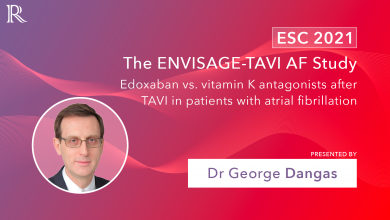Search results
Author(s):
George D Dangas
Added:
2 years ago
In this short video, Dr George Dangas (Mount Sinai Hospital, New York, NY, US) shares the findings from the ENVISAGE-TAVI AF hot line trial presented at ESC Congress 2021.
ENVISAGE-TAVI AF (Daiichi-Sankyo) compared the safety and efficacy of the DOAC edoxaban with VKAs (warfarin and its analogues) in atrial fibrillation patients with an indication for oral anticoagulation after successful TAVI.
…
View more
Author(s):
Grace Shu-wen Chang
,
Doreen Su-Yin Tan
Added:
3 years ago
Warfarin is a widely used anticoagulant for the prevention and treatment of thromboembolic disorders. It is well known that there is considerable inter-individual variability in warfarin dose requirements. Furthermore, because warfarin has a narrow therapeutic window, there is a risk of serious sequelae, such as thromboembolism or bleeding, if international normalised ratio (INR) levels fall into…
View more
Author(s):
Kazuya Hosokawa
,
Abe Kotaro
Added:
5 months ago
AHA 2023 — Dr Kazuya Hosokawa and Dr Abe Kotaro (Kyushu University Hospital, JP) join us to share the findings of the KABUKI trial (NCT04730037). The aim of KABUKI (Daiichi Sankyo) is to assess whether edoxaban, a direct factor Xa inhibitor, is noninferior to warfarin in preventing worsening of chronic thromboembolic pulmonary hypertension (CTEPH).This investigator-initiated, multicenter, phase 3…
View more
Author(s):
Freek WA Verheugt
Added:
3 years ago
The yearly incidence of stroke in patients with atrial fibrillation (AF) is approximately 5%,1 which is five times higher than in comparable populations in sinus rhythm (SR). The stroke risk largely depends on the underlying heart disease. In 'lone' AF (absence of heart disease) the stroke risk is only 0.5% per year,2 whereas in AF associated with rheumatic valvular heart disease (VHD), like…
View more
Author(s):
Freek WA Verheugt
Added:
3 years ago
The yearly incidence of stroke in patients with atrial fibrillation (AF) is approximately 5%, which is five times higher than in comparable populations in sinus rhythm (SR). The stroke risk largely depends on the underlying heart disease. In 'lone' AF (absence of heart disease) the stroke risk is only 0.5% per year, whereas in AF associated with rheumatic valvular heart disease (VHD), like mitral…
View more
Author(s):
Julia Sikorska
,
James Uprichard
Added:
3 years ago
For more than 50 years, oral vitamin K antagonists (VKAs) were the choice of anticoagulant for the long-term treatment and prevention of arterial and venous thromboembolic events (VTE). VKA treatment is safe and effective, if a high time in therapeutic range is achieved. However, achieving a stable, therapeutic international normalised ratio can prove challenging in the context of drug and food…
View more
Author(s):
Raffaele De Caterina
,
Giulia Renda
Added:
3 years ago
Limitations of Coumarin Derivatives in Atrial Fibrillation and the Quest for New Drugs
Warfarin and similar coumarin derivatives (vitamin K antagonists [VKAs]) clearly have the greatest efficacy among the currently available treatments (mostly aspirin) in preventing stroke in atrial fibrillation (AF).1 However, they carry a substantial risk of major bleeding (approximately 1.2% per year) and…
View more
Author(s):
Nadzeya Kuzniatsova
,
Gregory YH Lip
Added:
3 years ago
Atrial fibrillation (AF) is the most common cardiac rhythm disorder in everyday clinical practice, affecting 1–2% of the general population. The prevalence of AF is strongly age-dependent, increasing from <1% in patients under 60 years of age to almost 10% in patients 80 years of age or older1 and 17.8% in those 85 years of age and above.2 Population-based studies have shown lifetime risks for…
View more
Author(s):
Jose L Merino
,
José López-Sendón
Added:
3 years ago
Atrial fibrillation (AF) is the most frequent sustained arrhythmia. The estimation is that five million people suffer the disease in Europe,1 although this number may be even higher because many AF episodes are silent but still associated with a risk of complications.2–4 AF prevalence is increasing in developed countries in part due to the progressive increase in the mean age of the western…
View more
Author(s):
Minh That Ton
,
Tri Huynh Quang Ho
,
Viet Lan Nguyen
,
et al
Added:
4 months ago













